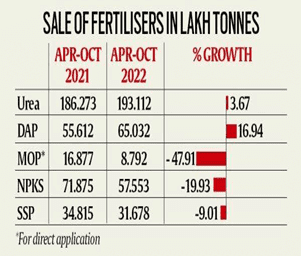

Context
According to data from the Ministry of Chemicals and Fertilisers, the sale of urea and di-ammonium phosphate (DAP) increased by 3.7% and 16.9%, respectively, from April to October 2022 over the previous year.
Background:
- The Government of India's two ambitious projects, the Soil Health Card and the neem-coating of urea were intended to promote the balanced utilization of fertilizers.
- However, the annual usage of urea (30 to 35 MT in the last five years) and DAP has increased over time.
- This means, that instead of providing a balanced mix of plant nutrients based on soil testing and crop requirements, Indian farmers are applying only urea and DAP – both containing 46% N and P, respectively.
About
About Di-ammonium Phosphate (DAP):
- It is a widely used fertilizer due to its outstanding physical qualities and nutritional content.
- It is free-flowing, dust-free, and does not normally cause any storage problems.
- DAP is highly water-soluble and has an acidic impact on soils due to the ammonia (NH4) it contains.
- When DAP is incorporated into the soil, it combines with water to produce HPO4 and NH4.
- Ammonium (NH4) uses the same path as urea.
- DAP contains phosphorus in the finest possible form (HPO4).
- Depending upon the soil reaction (pH), phosphorus exists in 3 forms which can be absorbed by plant roots.
- These are HPO4, H2PO4 and PO4. Phosphorus, which is immobile in soil, is not subjected to leaching losses.
Reasons for higher usage of urea and DAP:
- High subsidy on urea: The government has set the maximum retail price (MRP) for urea at Rs.5,628 per tonne, but the MRPs for other fertilizers are technically deregulated.
- DAP – a cheaper substitute: Companies have been instructed not to charge more than Rs.27,000/tonne for DAP (Rs.29,000-31,000/tonne for NPKS complexes), which contains 46% P and 18% N.
- Thus, the choice of fertilizers is mostly determined by price, rather than NPKS complexes or other micro and macronutrients in the fertilizers.
Issues:
Overuse of fertilizers: Excess use of urea has distorted India's fertilizer sector. Di-ammonium phosphate, or DAP, is experiencing a similar situation of over-application due to low cost.
The consequences of excessive intake of DAP and urea:
- The present NPK ratio of 13:5:1, as opposed to the optimal 4:2:1, would negatively affect crop yields.
- The lack of a balanced nutrient mix will have a negative impact on both plant and human health.


